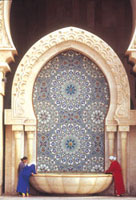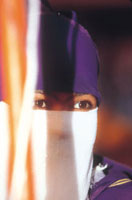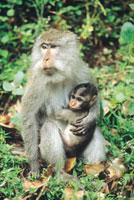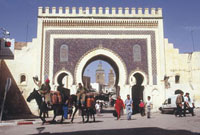Recipe For Gourmet Images
10 Ingredients To Bring Home Your Memories
Ever wonder what ingredients professional travel photographers use to make great on-location pictures? Here's my gourmet recipe. Getting Ready To "Cook." In the photo world, the term "cook" means to work your butt off to get great pictures. But before you can "cook" in the field, you need to do some homework on your destination. In other words, gather as much information as you can on where you are going. Search engines on the web are great resources (I use www.google. com). Simply type in any destination and you'll be amazed at all the info that's out there (in cyberspace) on just about anywhere on the planet. Doing your homework provides insight into a country's culture and customs. It gives you an idea of the things you want to photograph. It also helps reduce the number of surprises on site. Good "Utensils." A travel photographer's "utensils"--his or her cameras, lenses, and accessories--can help create great travel pictures. |
|||
Basic travel photography utensils include a camera body; wide angle zoom (17-35mm or 20-35mm) for landscapes and street scenes; a telephoto zoom (70-200mm) for people and wildlife pictures; and a flash for indoor, nighttime, and daylight fill-in flash photography. A more sophisticated system might include a 300mm lens or 100-400mm zoom for tighter wildlife photographs, a macro lens for close-ups, and an additional camera body--so you can always have two lenses at the ready. Plastic sandwich bags (to keep cameras dry and dust free) and a camera cleaning kit (to keep dust and grit out of your film chamber and off your film) are also practical utensils. When choosing your utensils, remember that you don't have to be a millionaire to take great travel pictures. After all, a camera system that costs several thousand dollars may not deliver better pictures than one that costs a few hundred dollars. Why? The answer lies in an old photo adage: "Cameras don't take pictures, people do." |
|||
Film. No doubt, film is one of the most important ingredients in the recipe for great travel pictures...if you use a film camera and not a digital camera, that is. Plain and simple: pack more film than you think you'll need and take several film speeds to meet all your needs. Professional travel photographers pack ISO 100 film for bright light; ISO 200, 400, and 800 films for low light and action. When traveling from site to site, pros try to carry as much film as possible and ask for a hand check at airport security checkpoints. Why? Because they know that if they ship their film through baggage, it may get totally ruined by new CAT scan machines, which have been installed at some airports for security purposes. Main Course. First and foremost, a travel photograph must have an interesting subject. Now that does not necessarily mean that the subject must be interesting to everyone. Rather, because photography is an art and a personal expression of one's creativity, the photo need only be interesting to the photographer. However, if you want to get your travel pictures published or exhibited, they should have mass appeal. |
|||
Good Exposure. Today's automatic cameras make it easy to get good exposures in most situations. But there are times when a camera's built-in exposure meter can be fooled, especially when a subject is backlighted. In this situation, follow this tip: the name of the game is to fill the frame...with the subject. Filling the frame gives your camera's light meter a specific target area. Filling the frame when taking flash pictures is also important when shooting on automatic. If your subject does not fill the frame, your camera's exposure system may try to illuminate the entire scene, thus washing out your subject. A Dash Of Color. We live in a world of color, so include some in your pictures! Look for color and think about how it can add impact to a scene. |
|||
For landscapes, use an extra color or supersaturated film--but don't use these films for people pictures: their faces will look too red. You can also add a dash of color to a picture. Pro shooters do this all the time. They pack colorful props and clothes to add impact to a scene or subject. Careful Composition. Generally speaking, you don't want to place your subject directly in the center of the frame; remember this tip: dead center is deadly. Rather, try to compose your pictures with the subject off to the left, right, top, or bottom of the frame. Or, follow the old photo tip: imagine a tic-tac-toe grid in your camera's viewfinder and place the main subject where the lines intersect. Good Timing. The difference between a great shot and a snapshot can be a second or two. When photographing moving subjects, try to anticipate the peak of action and shoot at the moment. When photographing people, look for pleasing expressions--and take lots of pictures because expressions change in the blink of an eye. Good timing also means waiting for the right light--or being in the right place at the right time. Shoot in the early morning or late afternoon and you'll get beautiful "warm colors" (deeper shades of red, orange, and yellow) in your pictures. Long shadows at these hours add a sense of depth and dimension to a scene. |
|||
Tell The Story. If you want to capture the "flavor" of your travel destination, you need to tell the whole story. In other words, take pictures of people, places, buildings, wildlife, and so on. Also look for unique angles and viewpoints. Sure, take the post card shots, but then ask yourself how you can picture the subject or scene in a unique way. Simmer. When you get back from a trip, let your pictures "simmer" for a while; don't judge them on quality and content right away. Why? Because the wonderful feelings of your vacation are still lingering in your mind--feelings that, as vivid as they may be, are not 100 percent relived when looking at pictures in your office or at the kitchen table. What's more, when you were taking pictures on your vacation, you saw the scene in three dimensions. But your little prints or slides have only two dimensions (unless you used a 3D camera). So, without the feelings and added dimension of depth, your pictures can't look as good as the actual scenes. It's really only after a few weeks, I've found, that I can judge if a picture was a success or a failure. Well, now it's my turn to "cook." Gotta start packing for my next trip. Ingredients For Great Travel Photos Getting Ready to Cook |























































